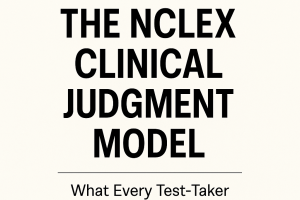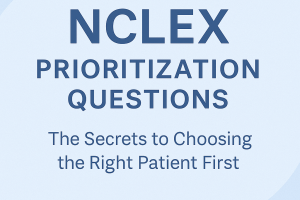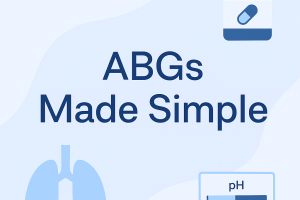Mastering Chronic Obstructive Pulmonary Disease (COPD) for the NCLEX Exam

Chronic Obstructive Pulmonary Disease (COPD) is a significant topic for the NCLEX exam, given its prevalence and impact on patients’ lives. Aspiring nurses must understand the pathophysiology, symptoms, diagnosis, and management of COPD to provide effective patient care. This blog post provides a comprehensive guide to help you prepare for the NCLEX exam.
What is COPD?
COPD is a chronic inflammatory lung disease characterized by obstructed airflow from the lungs. It encompasses two main conditions: emphysema and chronic bronchitis. COPD is primarily caused by long-term exposure to irritating gases or particulate matter, most often from cigarette smoke.
Pathophysiology
Emphysema
- Description: Emphysema involves the destruction of the alveoli (air sacs) in the lungs, leading to decreased surface area for gas exchange.
- Pathophysiology: Loss of alveolar elasticity causes air trapping and hyperinflation of the lungs, making it difficult for patients to exhale fully.
Chronic Bronchitis
- Description: Chronic bronchitis is defined by chronic inflammation of the bronchial tubes, leading to increased mucus production and persistent cough.
- Pathophysiology: The inflamed airways and excess mucus obstruct airflow, resulting in difficulty breathing.
Symptoms
- Dyspnea: Shortness of breath, especially during physical activities.
- Chronic Cough: Persistent cough that produces mucus (sputum).
- Wheezing: A whistling sound made during breathing.
- Chest Tightness: Feeling of constriction in the chest.
- Fatigue: Generalized tiredness and weakness.
- Frequent Respiratory Infections: Increased susceptibility to colds, flu, and other infections.
Risk Factors
- Smoking: The leading cause of COPD.
- Environmental Exposures: Long-term exposure to air pollutants, chemical fumes, and dust.
- Genetic Factors: A rare genetic disorder called alpha-1 antitrypsin deficiency can cause COPD.
Diagnosis
- Spirometry: A pulmonary function test that measures lung function, specifically the amount and speed of air a person can inhale and exhale.
- Chest X-ray: Helps identify emphysema and rule out other lung conditions.
- CT Scan: Provides a detailed view of the lungs and helps detect emphysema.
- Arterial Blood Gas Analysis: Measures the levels of oxygen and carbon dioxide in the blood to assess lung function.
- Pulse Oximetry: A non-invasive method to monitor oxygen saturation in the blood.
Management
Medications
- Bronchodilators: Medications that relax the muscles around the airways (e.g., albuterol, ipratropium).
- Inhaled Corticosteroids: Reduce airway inflammation (e.g., fluticasone, budesonide).
- Combination Inhalers: Contain both bronchodilators and corticosteroids (e.g., fluticasone/salmeterol).
- Phosphodiesterase-4 Inhibitors: Reduce inflammation and mucus production (e.g., roflumilast).
- Antibiotics: Used to treat respiratory infections that can exacerbate COPD.
Lifestyle Changes
- Smoking Cessation: The most crucial step in preventing COPD progression.
- Pulmonary Rehabilitation: A program that includes exercise training, nutritional advice, and education.
- Oxygen Therapy: For patients with severe COPD and low blood oxygen levels.
- Healthy Diet: Ensures adequate nutrition to maintain energy levels and muscle strength.
- Vaccinations: Regular flu and pneumonia vaccinations to prevent infections.
Surgical Options
- Lung Volume Reduction Surgery: Removes damaged lung tissue to improve breathing efficiency.
- Lung Transplant: In severe cases, a lung transplant may be considered.
NCLEX Preparation Tips for COPD
- Understand the Differences: Know the distinctions between emphysema and chronic bronchitis, including their pathophysiology and clinical manifestations.
- Memorize Key Symptoms: Be familiar with the common symptoms of COPD and how they present in patients.
- Diagnostic Tools: Understand the various diagnostic tests used for COPD and what they measure.
- Management Strategies: Learn the different medications, lifestyle changes, and surgical options for managing COPD.
- Complications: Be aware of potential complications of COPD, such as respiratory infections and pulmonary hypertension.
- Practice Questions: Use NCLEX practice questions focused on COPD to reinforce your knowledge and improve your test-taking skills.
Conclusion
Mastering the topic of Chronic Obstructive Pulmonary Disease is crucial for success on the NCLEX exam. By understanding the pathophysiology, symptoms, diagnosis, and management of COPD, you will be well-prepared to answer related questions and provide high-quality patient care. Keep studying, practicing, and applying your knowledge to ensure you excel in your nursing career.






